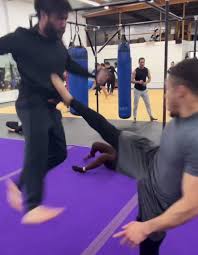Muscular fitness is another key component of a fitness training program. Strength training can help you increase bone strength and muscular fitness, and it can help you manage or lose weight. It can also improve your ability to do everyday activities. Aim to include strength training of all the major muscle groups into your fitness routine at least twice a week.
Most fitness centers offer various resistance machines, free weights, and other tools for strength training. Resistance bands are an inexpensive option. Your own body weight counts, too. Try push-ups, pull-ups, bent-knee sit-ups and leg squats.
The muscles in your abdomen, lower back, and pelvis (known as your core muscles) help protect your back and connect upper and lower body movements. Core strength is a key element of a well-rounded fitness training program.
Core exercises help train your muscles to brace the spine and enable you to use your upper and lower body muscles more effectively. A core exercise is any exercise that uses the trunk of your body without support, such as bridges, planks, bent-knee sit-ups, and fitness ball exercises.
Flexibility is an important aspect of physical fitness and it's a good idea to include stretching and flexibility activities in a fitness program. Stretching exercises can help increase flexibility, which can make it easier for you to do many everyday activities.
Stretching can also improve the range of motion of your joints and may promote better posture. Regular stretching can even help relieve stress and tension.
Consider stretching after you exercise—when your muscles are warm and receptive to stretching. If you want to stretch before a workout, warm up first by walking or exercising for 540 minutes before stretching.
Ideally, you'll stretch whenever you exercise. If you don't exercise regularly, you might want to stretch at least two to three times a week after warming up to maintain flexibility. Activities such as yoga promote flexibility, too.
Aim to incorporate aerobic fitness, strength training, core exercises, and flexibility/stretching into your exercise plan. It isn't necessary to fit each of these elements into every fitness session but factoring them into your regular routine can help you promote fitness for life and help prepare you for basic training.
Special Note To maintain weight and health, do 150 minutes of moderate-intensity physical activity per week. To lose weight, do 300 minutes of moderate-intensity physical activity per week. Stop using any tobacco or e-cigarette products immediately. If 21 or older, moderate your alcohol use and/or stop consumption of alcohol. Follow a low-fat nutrition plan. Dress accordingly for the elements. Invest in footwear that aligns with your fitness training program to reduce the chance of injury. Make sure you stay hydrated. Train now. Come ready! Minimum Physical Fitness Standards Bent-Knee Sit Ups Minimum Qualification for Graduation Male: 38 in one minute Female: 32 in one minute This exercise measures abdominal muscular endurance.
Lie on your back, knees bent, feet flat on the deck, hands cupped behind your ears, and if necessary, have someone hold your feet for stability. Keep your lower back on the deck and raise your upper body approximately 90 degrees, touching your elbows to your knees before beginning a controlled descent back to the deck. Once your lower back touches the deck, you can raise your upper body again. Do not tuck your chin into your chest as this causes strain on your neck.
Coast Guard PhysicalPlace your hands shoulder-width apart, your feet together, and your body forming a straight line from the shoulders to the ankles. Keep your body straight throughout the exercise. Lower your body until your chest touches the pad, then push up to the initial position by completely straightening the arms. Your goal is to exceed the physical fitness qualifications for graduation.
Stretch thoroughly before you begin running. Wear running shoes that fit properly. Pick a good running surface. If a track is not available, choose a level street to run on. Relax and breathe properly. Keep your elbows close to your sides to conserve energy. Practice lengthening your stride to reduce stress on your joints. When you get tired, slow to a brisk walk and continue pumping your arms to maintain aerobic heart rate. If you haven't run for a long time, or have never run, you should start out with a walk/run program.
Swimming Minimum Qualification for Graduation Jump off a six-foot platform into the pool, swim 100 meters, and tread water for five minutes. Swimming on your back is not permitted This exercise measures your ability to swim. It is strongly recommended that you show up already knowing the basics of how to swim and be comfortable In the water. There are seven essential components to a good swimming training program: stretching, warm-up, kick pull or drill sets, major set, timed swim, sprints, and cool-down.
The best way to achieve financial success is to have a solid, well thought out, and flexible plan. Good financial planning principles include determining where you are now and where you want to go financially. Once you know that, you can ask yourself how you are going to get there and use a budget or spending plan as a map to guide you to your financial destination. Recruit training is eight weeks long, but time may be extended due to medical, academic, disciplinary, or physical setbacks. Therefore, we strongly recommend that you make financial arrangements with your creditors to either delay payments for three months or pay in advance to cover the time you'll be away at recruit basic training.
When you arrive at basic training, at a minimum you must have a checking account and an ATM card. Your pay will be direct-deposited into this account. The only way you'll be able to access it will be to withdraw it from your personal account with your ATM card, so be sure you try your ATM card at least once before you arrive. ATMs are located at the Coast Guard Exchange.
The road to becoming a Coast Guardsman is filled with mental obstacles. You'll not only battle external forces; you'll battle forces within yourself that will test your mental limits. Those who prepare for this adversity will rise above and overcome the stressors of recruit basic training. Memorize your required knowledge and develop a daily routine now to be as prepared as possible for this challenging experience.
You'll be required to quote any one, or all, of the Eleven General Orders of a Sentry, the Phonetic Alphabet, and/ or Military Time from memory anytime, anywhere, and to anyone by the first Saturday of training. It is imperative that you learn this required knowledge prior to arriving for recruit basic training.
The following is an example of a daily routine that you could implement now to prepare for recruit basic training. Remember, only you know what your unique attributes and habits are, what your unique attributes and habits are, what your strengths and weaknesses are, and what influences they have over your current daily lifestyle.
he Coast Guard Boat Crew physical fitness test (PFT) measures muscular endurance and cardiorespiratory endurance. The test consists of either a 1.5-mile run or 12-minute swim, 1 minute of push-ups, and 1 minute of sit-ups. Currently, only USCG law enforcement and boat crew members are required to take the PFT.
Muscular endurance is the ability of your muscles to move or contract for long periods of time—or to contract as many times as possible in a set period of time. Examples might include holding a plank or doing as many push-ups as you can in 1 minute. The PFT’s push-up test and sit-up components measure muscular endurance and core stability because they require you to do a maximum number of repetitions in a set period of time.
Muscular endurance is often used as the base component of muscular fitness. The lighter weights used make it easier to learn the proper form before you move to heavier weights and train to improve muscular strength and power. To improve muscular endurance, the National Strength and Conditioning Association recommends lifting 67% or less of your one-rep max for at least 12 reps per set, with less than 30 seconds rest between sets. Training muscular endurance is one of the few times when limiting rest is helpful because it stresses your muscles’ energy systems by limiting the time for your muscles’ energy stores to replenish, forcing them to adapt to that stress.
For the push-up and sit-up events, basic core stability will be half the battle. For sit-ups, a general core strengthening program is just as effective at improving sit-up performance in a PFT as training by doing sit-ups in every workout. The benefit comes from reduced strain on your back and hip flexor muscles that could lead to pain or injury. For both exercises, start with a base core-strengthening program, then work on chest and arm muscle endurance to do push-ups.
When training to improve your muscular endurance, it might help to focus on one muscle group at a time, rather than doing supersets (a group of exercises one right after the other) of muscle groups. Supersets, while efficient time-wise, can build in too much rest for each specific muscle group to fully train for muscular endurance.









.jpg)

.jpg)
0 Comments
You are welcome to share your ideas with us in comments.
Emoji